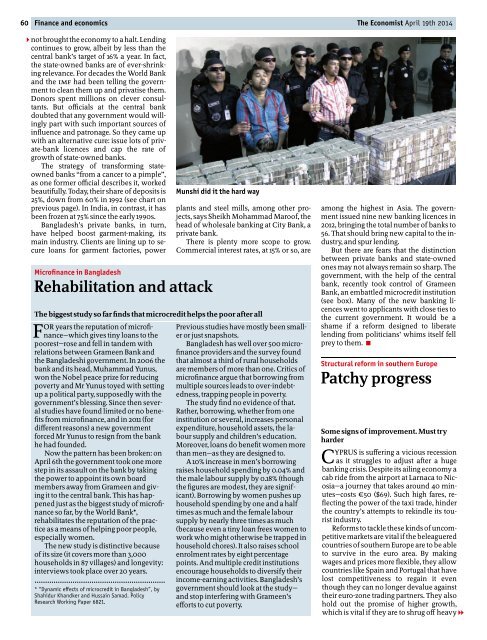The Economist - 19_25 April 2014
The Economist - 19_25 April 2014
The Economist - 19_25 April 2014
- No tags were found...
You also want an ePaper? Increase the reach of your titles
YUMPU automatically turns print PDFs into web optimized ePapers that Google loves.
60 Finance and economics <strong>The</strong> <strong>Economist</strong> <strong>April</strong> <strong>19</strong>th <strong>2014</strong>2 not brought the economy to a halt. Lendingcontinues to grow, albeit by less than thecentral bank’s target of 16% a year. In fact,the state-owned banks are of ever-shrinkingrelevance. For decades the World Bankand the IMF had been telling the governmentto clean them up and privatise them.Donors spent millions on clever consultants.But officials at the central bankdoubted that any government would willinglypart with such important sources ofinfluence and patronage. So they came upwith an alternative cure: issue lots of private-banklicences and cap the rate ofgrowth ofstate-owned banks.<strong>The</strong> strategy of transforming stateownedbanks “from a cancer to a pimple”,as one former official describes it, workedbeautifully. Today, their share ofdeposits is<strong>25</strong>%, down from 60% in <strong>19</strong>92 (see chart onprevious page). In India, in contrast, it hasbeen frozen at 75% since the early<strong>19</strong>90s.Bangladesh’s private banks, in turn,have helped boost garment-making, itsmain industry. Clients are lining up to secureloans for garment factories, powerMicrofinance in BangladeshRehabilitation and attackMunshi did it the hard wayplants and steel mills, among other projects,says Sheikh Mohammad Maroof, thehead of wholesale banking at City Bank, aprivate bank.<strong>The</strong>re is plenty more scope to grow.Commercial interest rates, at 15% or so, are<strong>The</strong> biggest study so farfinds that microcredit helps the poorafterallFOR years the reputation ofmicrofinance—whichgives tiny loans to thepoorest—rose and fell in tandem withrelations between Grameen Bankandthe Bangladeshi government. In 2006 thebank and its head, Muhammad Yunus,won the Nobel peace prize for reducingpoverty and Mr Yunus toyed with settingup a political party, supposedly with thegovernment’s blessing. Since then severalstudies have found limited or no benefitsfrom microfinance, and in 2011(fordifferent reasons) a new governmentforced Mr Yunus to resign from the bankhe had founded.Now the pattern has been broken: on<strong>April</strong> 6th the government tookone morestep in its assault on the bankby takingthe power to appoint its own boardmembers away from Grameen and givingit to the central bank. This has happenedjust as the biggest study ofmicrofinanceso far, by the World Bank*,rehabilitates the reputation ofthe practiceas a means ofhelping poor people,especially women.<strong>The</strong> new study is distinctive becauseof its size (it covers more than 3,000households in 87 villages) and longevity:interviews tookplace over 20 years...............................................................* “Dynamic effects of microcredit in Bangladesh”, byShahidur Khandker and Hussain Samad. PolicyResearch Working Paper 6821.Previous studies have mostly been smalleror just snapshots.Bangladesh has well over 500 microfinanceproviders and the survey foundthat almost a third ofrural householdsare members ofmore than one. Critics ofmicrofinance argue that borrowing frommultiple sources leads to over-indebtedness,trapping people in poverty.<strong>The</strong> study find no evidence ofthat.Rather, borrowing, whether from oneinstitution or several, increases personalexpenditure, household assets, the laboursupply and children’s education.Moreover, loans do benefit women morethan men—as they are designed to.A10% increase in men’s borrowingraises household spending by 0.04% andthe male labour supply by 0.18% (thoughthe figures are modest, they are significant).Borrowing by women pushes uphousehold spending by one and a halftimes as much and the female laboursupply by nearly three times as much(because even a tiny loan frees women toworkwho might otherwise be trapped inhousehold chores). It also raises schoolenrolment rates by eight percentagepoints. And multiple credit institutionsencourage households to diversify theirincome-earning activities. Bangladesh’sgovernment should lookat the study—and stop interfering with Grameen’sefforts to cut poverty.among the highest in Asia. <strong>The</strong> governmentissued nine new banking licences in2012, bringing the total number of banks to56. That should bring new capital to the industry,and spur lending.But there are fears that the distinctionbetween private banks and state-ownedones may not always remain so sharp. <strong>The</strong>government, with the help of the centralbank, recently took control of GrameenBank, an embattled microcredit institution(see box). Many of the new banking licenceswent to applicants with close ties tothe current government. It would be ashame if a reform designed to liberatelending from politicians’ whims itself fellprey to them. 7Structural reform in southern EuropePatchy progressSome signs ofimprovement. Must tryharderCYPRUS is suffering a vicious recessionas it struggles to adjust after a hugebanking crisis. Despite its ailing economy acab ride from the airport at Larnaca to Nicosia—ajourney that takes around 40 minutes—costs€50 ($69). Such high fares, reflectingthe power of the taxi trade, hinderthe country’s attempts to rekindle its touristindustry.Reformsto tackle these kindsofuncompetitivemarketsare vital ifthe beleagueredcountries ofsouthern Europe are to be ableto survive in the euro area. By makingwages and prices more flexible, they allowcountries like Spain and Portugal that havelost competitiveness to regain it eventhough they can no longer devalue againsttheir euro-zone trading partners. <strong>The</strong>y alsohold out the promise of higher growth,which is vital if they are to shrug off heavy1


